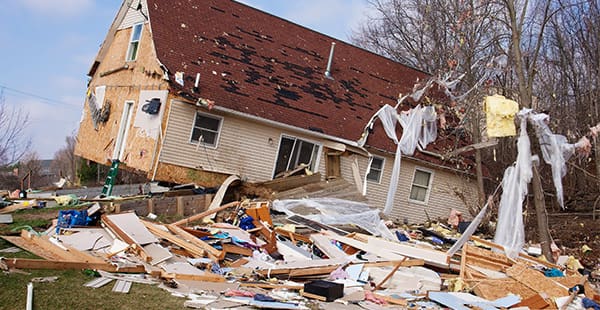01. What Is Short-Term Exposure?
What Is Short-Term Asbestos Exposure?
Short-term asbestos exposure generally refers to either a brief, one-time asbestos exposure or multiple exposure incidents occurring over a few days. In general, short-term exposure to asbestos dust or asbestos-containing materials poses a relatively low health risk.
Nearly everyone experiences exposure to small amounts of asbestos in the air, water and soil. This kind of environmental exposure is not considered a short-term exposure event because it is ongoing and normal.
Short-term exposures happen when people briefly experience a higher-than-normal interaction with asbestos.
Short-Term Asbestos Exposure vs. Long-Term Asbestos Exposure
Long-term asbestos exposure occurs regularly and over an extended period of time. In general, people are more likely to develop asbestos cancers from long-term exposures than short-term exposures.
Many people who worked at asbestos jobsites experienced long-term exposure. Families of asbestos workers may also have experienced long-term, secondhand exposure. This comes from accumulated interactions with fibers brought home on workers’ clothes and hair.
Length of time is only one factor affecting the health risks posed by exposure events. For example, short-term exposures may become more dangerous when airborne asbestos fibers are highly concentrated. Concentration level, asbestos fiber type and other factors also contribute to the health effects of any asbestos interaction.
02. Dangers of Short-Term Exposure
How Dangerous Is Short-Term Exposure to Asbestos?
Many people who experience short-term exposure never develop an asbestos disease. However, no safe amount of asbestos exposure exists. Researchers have documented asbestos-related diseases in some cases of brief exposures. But limited interactions are less likely to lead to asbestos cancer than long-term exposure.
Other factors may affect the risk posed by an exposure event, including:
- Asbestos type: All asbestos is dangerous, but some types of asbestos may be more dangerous than others. Studies suggest the amphibole type is more harmful than the chrysotile type.
- Concentration of fibers: Higher amounts of airborne asbestos during an exposure event may increase how dangerous the event is. Poor ventilation in the exposure area can heighten the risk of inhaling a high amount of fibers.
- Smoking: Smoking tobacco may increase the likelihood of developing asbestos diseases after exposure.
People who experience a limited or single exposure can speak to their healthcare provider. A doctor can watch for signs and symptoms of asbestos-related diseases, like mesothelioma and lung cancer. Mesothelioma and other asbestos illnesses may take many years to develop, if they develop at all.
Resources for Mesothelioma Patients
03. Cancer Risk
Can One-Time Exposure to Asbestos Cause Cancer?
One-time exposure to asbestos can cause diseases, including mesothelioma cancer. Researchers have found repeated exposure to asbestos increases the risk of developing asbestos-related cancers. The risk to individuals who have a one-time exposure to asbestos is generally lower compared to long-term or repeated exposure.
Asbestos exposure is linked to a number of diseases and conditions, including:
- Asbestosis
- Lung cancer
- Mesothelioma
- Ovarian cancer
- Pericardial effusion
- Peritoneal effusion
- Pleural effusion
- Pleural plaques
- Pleural thickening
People concerned about exposure can talk to their doctor. A medical professional can watch for the development of asbestos cancer. Early diagnosis and treatment may improve patient outcomes.
Does All Asbestos Exposure Lead to Mesothelioma?
Not every instance of asbestos exposure leads to mesothelioma or another asbestos-related illness. Malignant mesothelioma is a rare disease. In the United States, doctors diagnose about 3,000 new cases each year. Common cancers, like breast and colorectal cancer, average over 100,000 new cases each year.
The risk of developing mesothelioma increases with longer-term, more concentrated asbestos exposure.
04. Reducing Exposure
How to Reduce Asbestos Exposure
You can take precautions to help prevent both long- and short-term asbestos exposure. Being aware of possible exposure sources and working with professionals can help minimize risk. To limit the risk of exposure, you can:
- Avoid handling asbestos products: Many industrial and commercial products made before the 1980s contain asbestos. The fibers only become dangerous when airborne. But you may want to avoid these products altogether to minimize risk.
- Avoid potentially contaminated soil: Asbestos occurs naturally in the soil in areas throughout the United States. You can consult maps showing where these deposits occur and avoid them.
- Avoid potentially dangerous structures: Old industrial sites, abandoned schools and other poorly maintained properties may contain damaged asbestos materials. Avoiding these locations can help prevent exposure.
- Hire abatement professionals: Abatement professionals are available to inspect older homes and buildings for asbestos. If they find asbestos materials, they can take proper steps to seal or remove them.
The government also has many laws and regulations to help protect people from exposure. For example, the Environmental Protection Agency has enacted many regulations around air quality. And the Occupational Safety and Health Administration has regulations to help protect workers from dangerous toxins.
Today, the annual use of asbestos in the United States is much lower than it was before the 1980s. But legislators have stopped short of a full asbestos ban. Advocates say a full ban combined with increased awareness could help prevent exposures and increase public health.
05. Common Questions
Common Questions About Short-Term Asbestos Exposure
-
How much asbestos exposure causes cancer?
No level of asbestos exposure is completely risk-free. Anyone who inhales or ingests asbestos fibers faces a risk of developing asbestos diseases, like mesothelioma. But one-time exposures are generally considered lower risk than long-term exposures.
-
What if I was accidentally exposed to asbestos?
People accidentally exposed to asbestos need not panic. While no level of exposure is free from risk, most people exposed to asbestos never develop a related disease. But people may want to discuss any exposure with their doctors. A medical professional can watch for asbestos disease symptoms.
-
How long do you have to be around asbestos to be affected?
Most asbestos disease cases come from extended occupational asbestos exposure. But some cases have been documented in people with only brief exposures. Other factors, like smoking history, may also affect whether exposure leads to an asbestos disease.
-
Are there immediate signs of asbestos exposure?
Asbestos diseases like mesothelioma can take years, even decades, to develop. People do not experience immediate signs of asbestos disease after exposure. Keeping track of potential exposures and watching for symptoms could aid in early diagnosis. These steps may not affect any eventual treatment, but they can be helpful if a patient or family member seeks compensation.









